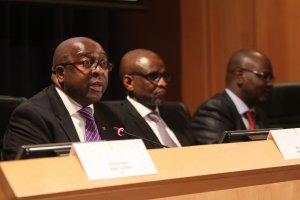DBSA aims for yearly disbursement records as it seeks to boost impact

Finance Minister and DBSA govenor Nhlanhla Nene and DBSA CEO Patrick Dlamini on the role of the bank in driving infrastructure development. Camera Work & Editing: Nicholas Boyd. Recorded: 18.9.2015
The Development Bank of Southern Africa (DBSA) – which disbursed a record R13-billion during 2015, from R12.7-billion in the prior year – remained optimistic that it could ramp up loan disbursements to R25-billion a year by 2018 as it sought to give greater emphasis to its developmental mandate.
The State-owned bank had been aiming to disburse R15-billion during 2015, but CEO Patrick Dlamini said the target had been affected by the several regional projects not closing as expected. He attributed this partly to a fall-off in donor flows to some projects and a decline in fiscal revenues in oil exporting countries.
Despite an expectation that the difficult market conditions would persist, the bank was nevertheless expecting disbursements to surge to R17.8-billion during the current financial year, before rising to R22-billion and R25-billion in 2017 and 2018 respectively. The 2016 projection was supported by approvals of R30.2-billion during the 2015 financial year and commitments of R17-billion.
Municipalities would remain the largest recipient of development finance, with the balance disbursed among the infrastructure sub- sectors of energy, water and sanitation, and transport in South Africa and the region.
During 2015, energy consumed the lion’s share (54%) of sectoral disbursements, but Dlamini indicated that there was likely to be a strong rise in the contribution of the transport and water sectors in the coming few years.
Projects in the rest of Africa were also expected to rise in prominence, as were infrastructure projects in South Africa’s eight large metropolitan areas. In 2015, municipal disbursements rose 117% to R5.4-billion, with disbursements to the large metros increasing by 340% to R3.7-billion.
Finance Minister and DBSA govenor Nhlanhla Nene said that, together with the National Treasury and the Department of Cooperative Governance and Traditional Affairs, the DBSA would seek to create partnerships with the private sector, particularly in building and maintaining urban infrastructure.
In addition, the DBSA would be expected to support government’s large-scale infrastructure investment plans, which had been identified as part of a larger nine-point plan to encourage a return to higher levels of economic growth.
However, Nene indicated that the official growth projections would be revised lower when the National Treasury’s updated the figures during the Medium-Term Budget Policy Statement, due for release on October 21.
In February, the National Treasury forecast gross domestic product growth of 2% for 2015, but the economy had not performed well in the first two quarters, which had already resulted in downward revisions from organisations such as the International Monetary Fund.
South Africa’s response to the economic headwinds lay in implementing “structural reforms” and pursuing domestic growth strategies, including ramping up infrastructure investment amid the interest rate “breathing space” that had been created by the decision of the US Federal Reserve not to raise interest rates in September.
“This is an opportunity where resources flow to areas where the policy rate is still higher,” Nene said.
The Minister also underlined the importance of the bank’s developmental impact, indicating that, “while he would have loved a dividend”, he felt that the capital was better retained in an institution that was starting to deliver on its developmental mandate. The bank reported a net profit of R1.2-billion in 2015, up from the R787-million recorded in 2014.
DBSA chairperson Jabu Moleketi added that the banks “developmental dividend” should be the primary focus, while stressing that financial sustainability was also crucial to delivering on that mission.
Comments
Press Office
Announcements
What's On
Subscribe to improve your user experience...
Option 1 (equivalent of R125 a month):
Receive a weekly copy of Creamer Media's Engineering News & Mining Weekly magazine
(print copy for those in South Africa and e-magazine for those outside of South Africa)
Receive daily email newsletters
Access to full search results
Access archive of magazine back copies
Access to Projects in Progress
Access to ONE Research Report of your choice in PDF format
Option 2 (equivalent of R375 a month):
All benefits from Option 1
PLUS
Access to Creamer Media's Research Channel Africa for ALL Research Reports, in PDF format, on various industrial and mining sectors
including Electricity; Water; Energy Transition; Hydrogen; Roads, Rail and Ports; Coal; Gold; Platinum; Battery Metals; etc.
Already a subscriber?
Forgotten your password?
Receive weekly copy of Creamer Media's Engineering News & Mining Weekly magazine (print copy for those in South Africa and e-magazine for those outside of South Africa)
➕
Recieve daily email newsletters
➕
Access to full search results
➕
Access archive of magazine back copies
➕
Access to Projects in Progress
➕
Access to ONE Research Report of your choice in PDF format
RESEARCH CHANNEL AFRICA
R4500 (equivalent of R375 a month)
SUBSCRIBEAll benefits from Option 1
➕
Access to Creamer Media's Research Channel Africa for ALL Research Reports on various industrial and mining sectors, in PDF format, including on:
Electricity
➕
Water
➕
Energy Transition
➕
Hydrogen
➕
Roads, Rail and Ports
➕
Coal
➕
Gold
➕
Platinum
➕
Battery Metals
➕
etc.
Receive all benefits from Option 1 or Option 2 delivered to numerous people at your company
➕
Multiple User names and Passwords for simultaneous log-ins
➕
Intranet integration access to all in your organisation



















